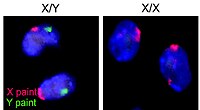
Photo from wikipedia
Major sex differences in mammalian tissues are functionally tied to reproduction and evolved as adaptations to meet different reproductive needs of females and males. They were thus directly controlled by… Click to show full abstract
Major sex differences in mammalian tissues are functionally tied to reproduction and evolved as adaptations to meet different reproductive needs of females and males. They were thus directly controlled by gonadal hormones. Factors encoded on the sex chromosomes also cause many sex differences in diverse tissues because they are present in different doses in XX and XY cells. The sex chromosome effects likely evolved not because of demands of reproduction, but as side effects of genomic forces that adaptively reduced sexual inequality. Sex-specific effects of particular factors, including gonadal hormones, therefore, are not necessarily explained as adaptations for reproduction, but also as potential factors offsetting, rather than producing, sex differences. The incorporation of these concepts would improve future teaching about sexual differentiation.
Journal Title: Cold Spring Harbor perspectives in biology
Year Published: 2022
Link to full text (if available)
Share on Social Media: Sign Up to like & get
recommendations!